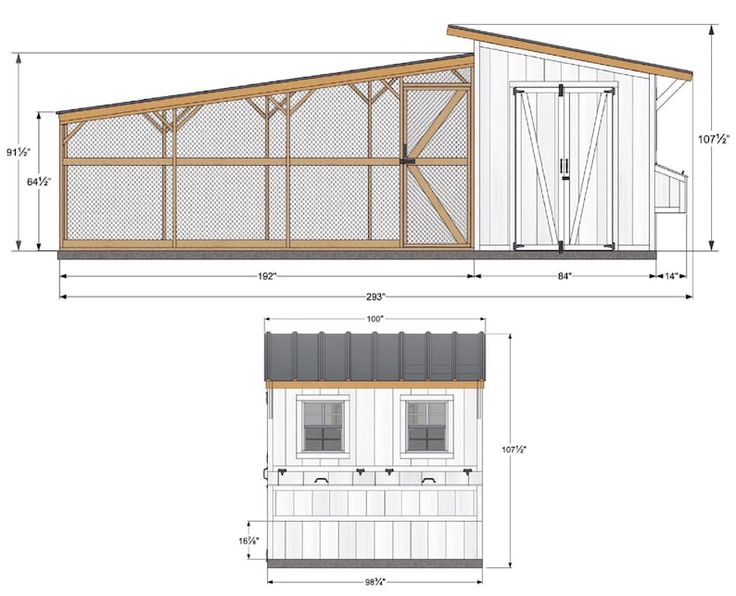By: Homestead Architecture Review
Backyard chicken keeping has become a popular trend among homesteaders and small farmers. The featured design here is a 23-foot chicken coop and run combo that combines durability, safety, and a sleek modern look. With a sloped roof, walk-in entry, and extended chicken run, this structure ensures both farmer convenience and flock comfort.
Let’s break down the measurements, features, and step-by-step building process so you can recreate this coop on your farm or backyard.
1. Dimensions at a Glance
- Total Length: 283” (23 ft 7 in)
- Run Length: 192” (16 ft)
- Henhouse Length: 84” (7 ft)
- Height:
- Coop section: 107 ½” (approx. 9 ft)
- Run section: 64 ½”–91 ½” (sloping for drainage)
- Width (Front view): 98 ½” (8 ft 2 in)
This size comfortably houses 12–16 chickens, giving them a protected run and a secure shelter.
2. Front View Features
- Two large double barn doors provide farmer access to the coop interior.
- Coop roof slopes backward, helping with water drainage.
- Built-in nesting boxes are attached at the back with exterior access.
- The front face shows two windows with mesh covering, allowing ventilation and light inside.
3. Side View Features
- Long run space with full hardware mesh enclosure.
- Run door allows walk-in access for cleaning and feeding.
- Roof slants from 91 ½” down to 64 ½”, giving excellent weather protection.
- Reinforced framing ensures stability against wind and predator attacks.
4. Step-by-Step Construction Guide
Step 1: Foundation
- Create a level base, 23 ft long by 8 ft wide.
- Use concrete blocks, treated 4x4s, or gravel for drainage.
- Keep the foundation raised to avoid flooding.
Step 2: Frame Construction
- Build the coop frame with 2×4 or 2×6 lumber.
- Divide the sections: 7 ft for coop, 16 ft for chicken run.
- Add cross-bracing for roof support and wind resistance.
Step 3: Coop Walls & Openings
- Install plywood or siding panels for the coop.
- Cut spaces for two front windows with hardware mesh for ventilation.
- Fit the large double barn doors at the front.
- Add a chicken pop door with a ramp leading into the run.
Step 4: Run Section
- Enclose the run with ½-inch welded hardware cloth (predator-proof).
- Ensure the mesh is buried at least 12 inches underground to prevent digging predators.
- Build a walk-in run door for farmer access.
Step 5: Roofing
- Use corrugated metal or asphalt sheets for the sloped roof.
- Extend the overhang to keep rain away from walls.
- The coop section stands tall at 9 ft, while the run gradually slopes down to 5 ft 4 in.
Step 6: Nesting Boxes & Roosts
- Add exterior nesting boxes on the side or back wall (approx. 16” deep).
- Install roosting bars inside, about 2–3 ft off the ground.
- Ensure 8–10 inches of perch space per bird.
Step 7: Final Touches
- Add removable litter trays inside for easy cleaning.
- Place feeders and waterers both inside the coop and run.
- Optional: Solar-powered automatic chicken door for convenience.
5. Key Benefits of This Design
✔ Walk-in access for easy cleaning and feeding.
✔ Large sloped roof ensures proper drainage and durability.
✔ Predator-proof run keeps chickens safe from hawks, foxes, and raccoons.
✔ Ventilated and well-lit coop supports chicken health.
✔ Roomy space comfortably houses up to 16 chickens.
6. Why This Coop is Perfect for Homesteads
This design strikes the perfect balance between functionality and simplicity. With its long walk-in run and spacious henhouse, it suits both small backyard keepers and serious homesteaders.
Farmers love the sloped roof design because it naturally sheds rain and snow, while the large mesh windows keep the inside fresh and odor-free.
✅ Final Note: If you want a coop that’s durable, easy to maintain, and flock-friendly, this 23-foot chicken coop with a sloped roof is a top choice. With the right materials, it can last 10–15 years, offering security and comfort for your chickens.
